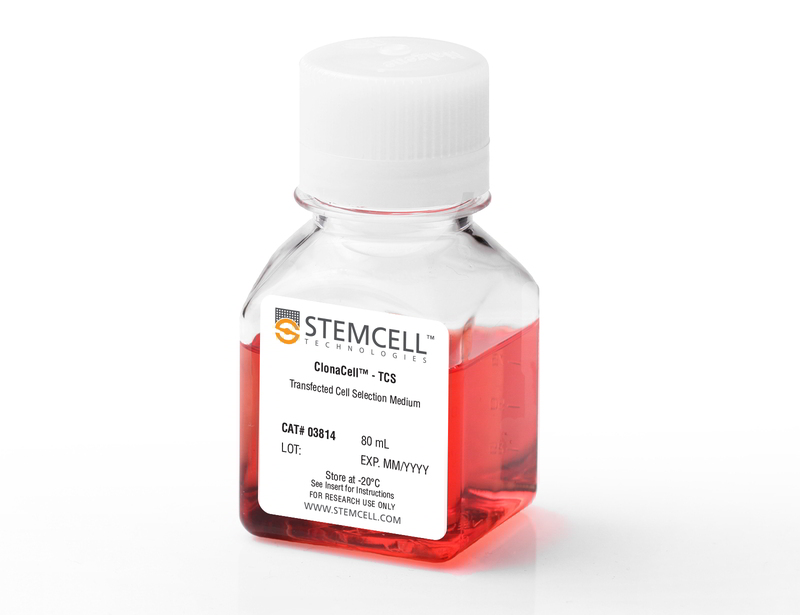ClonaCell™-TCS Medium
Semi-solid methylcellulose-based medium for selecting and cloning suspension-adapted and adherent cells (serum-containing)
概要
ClonaCell™-TCS Medium is a serum-containing methylcellulose-based semi-solid medium that can be used for selecting and cloning a variety of suspension-adapted cell lines, including CHO-S and hybridomas. It can also be used for semi-solid cloning of some cell lines that grow adherently in the presence of serum, including CHO-K1, BHK-1, and HEK-293. This medium contains pre-selected fetal bovine serum (FBS) and bovine serum albumin (BSA) and supports robust growth of a wide variety of cell types. ClonaCell™-TCS Medium does not contain selection agents.
Benefits of semi-solid cloning:
• Individual cells are suspended in viscous medium and form physically separated, discrete colonies that are easily isolated.
• Monoclonal cell lines are isolated in less time using fewer resources compared with selection and cloning by limiting dilution.
• Diverse clones with a wide range of growth rates and productivities form discrete colonies in the viscous medium. As a result, rare and high-producing clones can be individually isolated more easily using simultaneous selection and cloning in semi-solid medium compared with selection in bulk liquid cultures.
Benefits of semi-solid cloning:
• Individual cells are suspended in viscous medium and form physically separated, discrete colonies that are easily isolated.
• Monoclonal cell lines are isolated in less time using fewer resources compared with selection and cloning by limiting dilution.
• Diverse clones with a wide range of growth rates and productivities form discrete colonies in the viscous medium. As a result, rare and high-producing clones can be individually isolated more easily using simultaneous selection and cloning in semi-solid medium compared with selection in bulk liquid cultures.
Advantages
• Supports high cloning efficiency and robust colony formation for a variety of cell lines such as: B16F-10, BaF/3, BHK-1, CHO-DG44, CHO-K1, CHO-S, FD-5, HEK-293, Jurkat Daudi, K562, Molt-4, UT-7
Contains
• IMDM (Iscove's Modified Dulbecco's Medium)
• Methylcellulose
• Pre-selected serum
• Bovine serum albumin
• 2-Mercaptoethanol
• Phenol red
• L-Glutamine
• Other ingredients
• Methylcellulose
• Pre-selected serum
• Bovine serum albumin
• 2-Mercaptoethanol
• Phenol red
• L-Glutamine
• Other ingredients
Subtype
Semi-Solid Media, Specialized Media
Cell Type
CHO Cells, HEK-293, Hybridomas, Other
Species
Mouse, Other
Application
Cell Culture, Semi-Solid Cloning
Brand
ClonaCell
Area of Interest
Antibody Development, Cell Line Development, Hybridoma Generation
技术资料
| Document Type | 产品名称 | Catalog # | Lot # | 语言 |
|---|---|---|---|---|
| Product Information Sheet | ClonaCell™-TCS Medium | 03814 | All | English |
| Safety Data Sheet | ClonaCell™-TCS Medium | 03814 | All | English |
数据及文献
Publications (12)
Leukemia 2018 MAR
The T-cell leukemia-associated ribosomal RPL10 R98S mutation enhances JAK-STAT signaling.
Abstract
Abstract
Several somatic ribosome defects have recently been discovered in cancer, yet their oncogenic mechanisms remain poorly understood. Here we investigated the pathogenic role of the recurrent R98S mutation in ribosomal protein L10 (RPL10 R98S) found in T-cell acute lymphoblastic leukemia (T-ALL). The JAK-STAT signaling pathway is a critical controller of cellular proliferation and survival. A proteome screen revealed overexpression of several Jak-Stat signaling proteins in engineered RPL10 R98S mouse lymphoid cells, which we confirmed in hematopoietic cells from transgenic Rpl10 R98S mice and T-ALL xenograft samples. RPL10 R98S expressing cells displayed JAK-STAT pathway hyper-activation upon cytokine stimulation, as well as increased sensitivity to clinically used JAK-STAT inhibitors like pimozide. A mutually exclusive mutation pattern between RPL10 R98S and JAK-STAT mutations in T-ALL patients further suggests that RPL10 R98S functionally mimics JAK-STAT activation. Mechanistically, besides transcriptional changes, RPL10 R98S caused reduction of apparent programmed ribosomal frameshifting at several ribosomal frameshift signals in mouse and human Jak-Stat genes, as well as decreased Jak1 degradation. Of further medical interest, RPL10 R98S cells showed reduced proteasome activity and enhanced sensitivity to clinical proteasome inhibitors. Collectively, we describe modulation of the JAK-STAT cascade as a novel cancer-promoting activity of a ribosomal mutation, and expand the relevance of this cascade in leukemia.
Nature Medicine 2016 NOV
DNMT3A mutations promote anthracycline resistance in acute myeloid leukemia via impaired nucleosome remodeling.
Abstract
Abstract
Although the majority of patients with acute myeloid leukemia (AML) initially respond to chemotherapy, many of them subsequently relapse, and the mechanistic basis for AML persistence following chemotherapy has not been determined. Recurrent somatic mutations in DNA methyltransferase 3A (DNMT3A), most frequently at arginine 882 (DNMT3A(R882)), have been observed in AML and in individuals with clonal hematopoiesis in the absence of leukemic transformation. Patients with DNMT3A(R882) AML have an inferior outcome when treated with standard-dose daunorubicin-based induction chemotherapy, suggesting that DNMT3A(R882) cells persist and drive relapse. We found that Dnmt3a mutations induced hematopoietic stem cell expansion, cooperated with mutations in the FMS-like tyrosine kinase 3 gene (Flt3(ITD)) and the nucleophosmin gene (Npm1(c)) to induce AML in vivo, and promoted resistance to anthracycline chemotherapy. In patients with AML, the presence of DNMT3A(R882) mutations predicts minimal residual disease, underscoring their role in AML chemoresistance. DNMT3A(R882) cells showed impaired nucleosome eviction and chromatin remodeling in response to anthracycline treatment, which resulted from attenuated recruitment of histone chaperone SPT-16 following anthracycline exposure. This defect led to an inability to sense and repair DNA torsional stress, which resulted in increased mutagenesis. Our findings identify a crucial role for DNMT3A(R882) mutations in driving AML chemoresistance and highlight the importance of chromatin remodeling in response to cytotoxic chemotherapy.
Leukemia 2016 MAR
Generation of the Fip1l1–Pdgfra fusion gene using CRISPR/Cas genome editing
Abstract
Abstract
BMC Biotechnology 2016 DEC
Generating aldehyde-tagged antibodies with high titers and high formylglycine yields by supplementing culture media with copper(II)
Abstract
Abstract
BACKGROUND The ability to site-specifically conjugate a protein to a payload of interest (e.g., a fluorophore, small molecule pharmacophore, oligonucleotide, or other protein) has found widespread application in basic research and drug development. For example, antibody-drug conjugates represent a class of biotherapeutics that couple the targeting specificity of an antibody with the chemotherapeutic potency of a small molecule drug. While first generation antibody-drug conjugates (ADCs) used random conjugation approaches, next-generation ADCs are employing site-specific conjugation. A facile way to generate site-specific protein conjugates is via the aldehyde tag technology, where a five amino acid consensus sequence (CXPXR) is genetically encoded into the protein of interest at the desired location. During protein expression, the Cys residue within this consensus sequence can be recognized by ectopically-expressed formylglycine generating enzyme (FGE), which converts the Cys to a formylglycine (fGly) residue. The latter bears an aldehyde functional group that serves as a chemical handle for subsequent conjugation. RESULTS The yield of Cys conversion to fGly during protein production can be variable and is highly dependent on culture conditions. We set out to achieve consistently high yields by modulating culture conditions to maximize FGE activity within the cell. We recently showed that FGE is a copper-dependent oxidase that binds copper in a stoichiometric fashion and uses it to activate oxygen, driving enzymatic turnover. Building upon that work, here we show that by supplementing cell culture media with copper we can routinely reach high yields of highly converted protein. We demonstrate that cells incorporate copper from the media into FGE, which results in increased specific activity of the enzyme. The amount of copper required is compatible with large scale cell culture, as demonstrated in fed-batch cell cultures with antibody titers of 5 g textperiodcentered L(-1), specific cellular production rates of 75 pg textperiodcentered cell(-1) textperiodcentered d(-1), and fGly conversion yields of 95-98 %. CONCLUSIONS We describe a process with a high yield of site-specific formylglycine (fGly) generation during monoclonal antibody production in CHO cells. The conversion of Cys to fGly depends upon the activity of FGE, which can be ensured by supplementing the culture media with 50 uM copper(II) sulfate.
2016
Generation of recombinant modified Vaccinia Virus Ankara encoding VP2, NS1, and VP7 proteins of bluetongue virus
Abstract
Abstract
Modified Vaccinia Virus Ankara (MVA) is employed widely as an experimental vaccine vector for its lack of replication in mammalian cells and high expression level of foreign/heterologous genes. Recombinant MVAs (rMVAs) are used as platforms for protein production as well as vectors to generate vaccines against a high number of infectious diseases and other pathologies. The portrait of the virus combines desirable elements such as high-level biological safety, the ability to activate appropriate innate immune mediators upon vaccination, and the capacity to deliver substantial amounts of heterologous antigens. Recombinant MVAs encoding proteins of bluetongue virus (BTV), an Orbivirus that infects domestic and wild ruminants transmitted by biting midges of the Culicoides species, are excellent vaccine candidates against this virus. In this chapter we describe the methods for the generation of rMVAs encoding VP2, NS1, and VP7 proteins of bluetongue virus as a model example for orbiviruses. The protocols included cover the cloning of VP2, NS1, and VP7 BTV-4 genes in a transfer plasmid, the construction of recombinant MVAs, the titration of virus working stocks and the protein expression analysis by immunofluorescence and radiolabeling of rMVA infected cells as well as virus purification.
Molecular Cancer 2015 DEC
Long noncoding RNA, CCDC26, controls myeloid leukemia cell growth through regulation of KIT expression
Abstract
Abstract
BACKGROUND Accumulating evidence suggests that some long noncoding RNAs (lncRNAs) are involved in certain diseases, such as cancer. The lncRNA, CCDC26, is related to childhood acute myeloid leukemia (AML) because its copy number is altered in AML patients. RESULTS We found that CCDC26 transcripts were abundant in the nuclear fraction of K562 human myeloid leukemia cells. To examine the function of CCDC26, gene knockdown (KD) was performed using short hairpin RNAs (shRNAs), and four KD clones, in which CCDC26 expression was suppressed to 1% of its normal level, were isolated. This down-regulation included suppression of CCDC26 intron-containing transcripts (the CCDC26 precursor mRNA), indicating that transcriptional gene suppression (TGS), not post-transcriptional suppression, was occurring. The shRNA targeting one of the two CCDC26 splice variants also suppressed the other splice variant, which is further evidence for TGS. Growth rates of KD clones were reduced compared with non-KD control cells in media containing normal or high serum concentrations. In contrast, enhanced growth rates in media containing much lower serum concentrations and increased survival periods after serum withdrawal were observed for KD clones. DNA microarray and quantitative polymerase chain reaction screening for differentially expressed genes between KD clones and non-KD control cells revealed significant up-regulation of the tyrosine kinase receptor, KIT, hyperactive mutations of which are often found in AML. Treatment of KD clones with ISCK03, a KIT-specific inhibitor, eliminated the increased survival of KD clones in the absence of serum. CONCLUSIONS We suggest that CCDC26 controls growth of myeloid leukemia cells through regulation of KIT expression. A KIT inhibitor might be an effective treatment against the forms of AML in which CCDC26 is altered.


